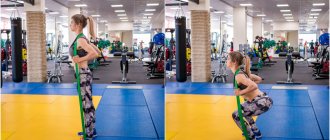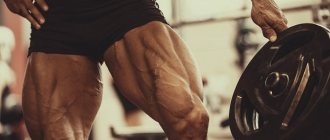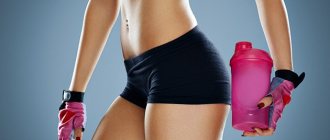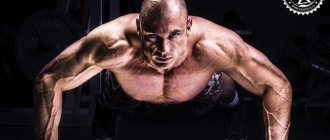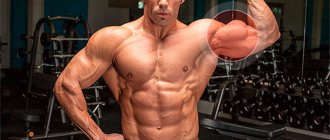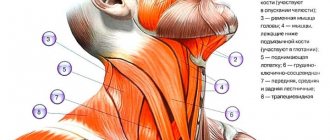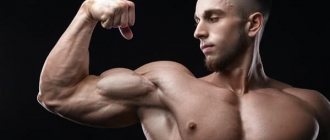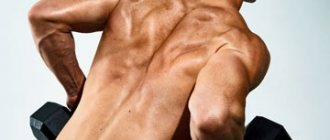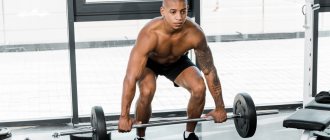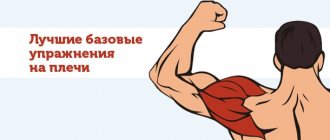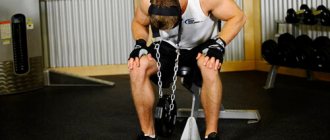Many men over 40 would like to have a sculpted torso with well-developed muscles, but consider this desire impossible because they do not have the opportunity to go to the gym. However, this is not a reason to give up - you can pump up sculpted muscles and increase strength at home. Of course, training in a rocking chair has many advantages - a variety of simulators and equipment, instructor guidance, communication. In addition, many people are encouraged to attend training by purchasing a subscription. And home workouts are free, so you only have to rely on your consciousness and willpower. Indeed, in order to regularly study at home, the motivation must be very strong.
To get motivated, just look at the facts. The growing belly in men with age is the so-called abdominal obesity, which worsens not only appearance, but also health. Scientists have proven that fat deposited behind the peritoneum is an inseparable companion to atherosclerosis, hypertension and diabetes, which significantly reduce life expectancy. In addition, excess fat reduces testosterone levels, which is of no use to men. After 40 years, all these pathological processes in the male body accelerate, so the earlier you start regular training, the greater the chance of maintaining health and living a long, fruitful life.
Basic anatomy
The muscles of the upper body, that is, those that form the torso, include a fairly large array - the abs, chest and back. In turn, each of them is divided into subgroups.
There are also superficial and deep muscles.
The superficial ones are respectively located on the surface of the body and are clearly visible visually. Close attention is paid to their development in bodybuilding.
Next we will talk about this category.
The deep ones lie under the surface ones, sometimes in two or three layers. They are not visible from the outside, but also perform a number of important functions in the body. Mainly stabilizing and motor.
Back
The largest superficial back muscles include:
- Trapezoidal
- Lat
- Round
- Diamond-shaped
- Lumbar
Part of the trapezoid is located at the back of the neck (upper part), and its second section (back, lower part) goes down and is located in the back.
Although the upper trapezius is often referred to as the neck, it is trained on the same day as the back.
All of the muscles mentioned are located on the back of the body.
Their main function is to stabilize the spine in various starting positions.
They also perform traction movements, when various objects are pulled to the body from above, in the horizontal plane and below with the help of their hands.
The trapezius lifts the shoulder blades up and draws the shoulders back.
The widest, round and diamond-shaped muscles work in one connection, responsible for bringing the arm closer to the body in different planes.
The lumbar muscles extend the torso from different bending positions.
Breast
The superficial muscles of the chest include the pectoralis major, intercostals and serratus. They are located in front, in the upper part of the body.
The largest and strongest is, of course, the pectoralis major.
Among the main functions, first of all, respiratory. All of them are actively involved in the breathing process.
The movements are performed of a pressing nature. This is straightening the bent arm in front of you. For example, as in the bench press.
Or bringing a straight arm to the body from different positions, as in lying dumbbell flyes and pullovers.
As for the intercostal and serratus, they are small muscles that perform auxiliary functions. As a rule, indirect load during chest training is enough for their development.
Stomach
The superficial abdominal muscles include the rectus and oblique.
The straight line is located on the front surface of the body and forms “cubes”. Oblique, respectively, on the sides of the body.
Together with the lumbar muscles, the press forms a kind of corset for the spine. The health of the back depends on their tone.
Therefore, in all strength sports, close attention is paid to training the abdomen and lower back. This reduces the risk of spinal injury by protecting it from high compression loads.
The rectus abdominis muscle brings the chest closer to the pelvis, or vice versa - the pelvis to the chest.
Obliques perform sideways, diagonal, and circular rotations of the body.
Why do you need to pump up the latissimus muscles?
The latissimus dorsi muscles, also popularly called “wings,” are, as their name suggests, the widest muscles on the back.
Together with the trapezius and lumbar muscles, they form an aesthetically attractive back relief. If the latissimus muscle is in good athletic shape, then it resembles a bird's wings in a folded position. By systematically doing exercises to strengthen the latissimus dorsi muscle, you will achieve the ideal triangular back shape for men. Using bodyweight strength exercises
and as a result, becoming the owner of a toned and strong back, you will not only make its visual appearance attractive, but also improve your posture. When the latissimus muscle is insufficiently developed, the shoulders tend to lean forward, forming a stooped body shape. Among other beneficial effects, exercises on the latissimus dorsi muscles serve as a good prevention of diseases such as osteochondrosis and scoliosis.
Muscular system of the back
is divided into two main parts - deep muscles and superficial.
The superficial part has a two-layer structure and directly relates to the latissimus muscle, with which the Lazy Sloth expects you to work hard and effectively with your own weight. Its location is in the lower and partially central part of the back, divided into two symmetrical halves. The main functions of the latissimus muscle
are adduction and extension of the shoulder joints, internal rotation, downward movement of the shoulder part of the body by moving the head with the scapula. Also, during its contraction, the latissimus muscle promotes bending and extension movements of the torso. In addition, when the arms are fixed, this muscle is used as an auxiliary for breathing, participating in the expansion of the chest.
By ensuring the raising and lowering of the arms, moving them to the sides and moving them back, the latissimus muscle is actively involved in various sports; strength training on the core and shoulder girdle, gymnastic exercises on the crossbar and other similar equipment cannot be done without its involvement.
In artistic gymnastics and weightlifting, this muscle provides a static load during stabilization of the arms when they are raised. The latissimus muscle tends to move the head of the shoulder down, thereby, working in conjunction with the pectoralis major muscle, it prevents the body from lowering when holding the body on the horizontal bar, uneven bars or gymnastic rings. The muscle is also capable of stretching the torso upward with fixed arms, for example, this is especially evident in pole vaulting. In different types of swimming, the latissimus dorsi muscle performs internal motor rotation. During pull-ups, rowing, skiing, projectile throwing and rock climbing, this muscle, after raising the shoulder, extends it. In sports such as volleyball, handball and tennis, the wings of the back take an important part in combinations of movements.
Thus, exercises for developing the latissimus dorsi muscles
contain both practical significance, helping to achieve better physical characteristics and increasing athletic capabilities, and directly affect the beauty of your body figure, contributing, at the same time, to the improvement of the musculoskeletal system. Next, we will look at what approach to training is necessary for exercises with your own weight at home to bring truly tangible and useful results.
What exercises to choose for training
The main condition for conducting the most effective upper training is the correct exercises for the torso.
In bodybuilding, they are divided into basic, or, as they also call it, multi-joint, and isolating, that is, single-joint.
When exercising to increase muscle mass and strength, priority in training is given to basic movements. They should make up 70% of the total number of exercises.
The main purpose of isolating movements is to “top up” tired, already worked muscles after completing the base.
They are also used to improve the detailing of specific parts of the body and polish their shape. Therefore, it is most important to use insulation during terrain training.
Below is a list of exercises, mainly consisting of popular basic movements that will bring tangible results.
The exception would be the abdomen, where most of the exercises are isolated.
Training according to the regime
This is an important point, since you should not exhaust yourself with training at first; the load should be increased gradually. The muscles of the sternum, like others, require rest and respite. This is due to the fact that they receive many microtraumas, and the muscles need time to recover, but the break between classes should not be too long.
The video shows how to train the pectoral muscles at home
Important! After working out one of the muscle groups, the break should not exceed five days. You should also not neglect proper nutrition. To speed up muscle recovery, protein foods are required.
This material will be perfectly complemented by the following publications:
- How to pump up your chest on the uneven bars: a set of effective techniques
- Chest training program: split programs from professionals
Recommendations for load selection
The torso muscles are quite different in their anatomical structure and functions. Therefore, rapid progress involves selecting different types of loads in the training process.
The back muscles are strength muscles that “love” heavy weights. Therefore, in most cases, heavy and medium weights are used here.
The main range of repetitions in basic exercises is 6-10 times, in isolating exercises - 10-15 times in one approach.
The chest , as a rule, is pumped with an average weight of weights. The range of repetitions in basic exercises is 8-12 times, in isolating exercises – 12-15.
The abdominal muscles are worked out without the use of weights, or with fairly light weights. In this case, the exercises use a high repetition range - 20-30 times in one approach.
The standard number of working approaches for all torso muscles is 3-4 in one exercise.
Rest between approaches when training aimed at increasing muscle mass is 2-3 minutes in multi-joint exercises, and in isolating exercises - 1-2 minutes.
A set of exercises with your own weight
Some exercises using our own body weight have been known to us since school, however, there we performed them under the supervision of teachers who talked about the correct technique. Let's check if you remember the teachers' advice.
Bodyweight exercises for arm muscles
A classic bodyweight exercise is the pull-up.
.
It is recommended to stick to a grip slightly wider than shoulder width. You need to pull yourself up not for speed, but for efficiency. Pull-ups should be performed slowly, without jerking, to gradually target the various muscles in your arms and back. The number of approaches and the number of pull-ups in each of them must be adjusted depending on your abilities. The most optimal scheme would be “10x4”, i.e. 4 sets of 10 pull-ups each
. The load should be felt, but not excessive. By the way, during pull-ups, it’s not even the muscles of the arms that work the most, but the muscles of the back, so such exercises will be especially useful for people with sedentary work.
Despite the apparent simplicity of the pull-up technique, this type of exercise has many varieties. They are divided mainly by grip types. A close grip involves placing your hands in such a way that your hands touch each other, and a reverse grip is recommended to use to increase the load on the biceps.
Another popular arm exercise using body weight is push-ups
. If simple push-ups seem too easy to you, then you can slightly complicate the technique of performing this exercise, for example, linger for a few seconds at the lowest point without touching your chest to the floor, or while lifting, push off the floor and clap.
Bodyweight exercises for leg and body muscles
Using exercises to overcome your own body weight, you can effectively train your legs. The best way to do this is with squats
. Remember that during squats your heels should not leave the floor and you should be able to easily maintain your balance. You need to squat smoothly and deeply. If you can easily perform 4 sets of 15 squats, then you need to think about options for complicating the exercise.
For example, you can start squatting on one leg using something as support, such as a chair. The supporting leg should bend at the knee to a right angle, and the second leg should be placed on the chair so as not to lose balance. Legs must be alternated. The same “4x10” scheme will be optimal.
Finally, let’s remember or talk about a complex exercise for the whole body with the unusual name “ burpee”
” or “
burpees
”.
With this exercise you can train all the muscles of the body at once. Burpees have a “classic” (more complex) and a lightweight version. The difference between the options lies mainly in the speed of execution and its continuity. The simplified version is a combination of individual elements from a standing position, performed according to the following scheme
:
- squat down;
- place your hands on the floor;
- straighten your legs back to the plank position one by one;
- return to the starting position;
- jump up and clap in front of you;
- repeat the exercise.
Scheme of a complicated version of burpee
:
- squat down;
- place your hands on the floor;
- through the jump, straighten both legs back to the “plank” position;
- return to the starting position;
- jump up high and clap in front of you or above your head;
- repeat the exercise.
In the complicated version of the burpee, you need to spend no more than 2-3 seconds on each exercise, i.e. maintain a fairly high pace. Over time, you can begin to do additional push-ups from the plank position. Burpees are recommended to be performed in 2 sets of 8-10 exercises.
in everyone.
To achieve noticeable results, you need to exercise regularly, preferably every day or 4-5 times a week.
. The load can be gradually increased, but not sharply and only when you really begin to work out the current load well. Remember that it is better to do fewer exercises per set for more sets than to try to stretch each set. Rest between approaches is necessary, but minimal, no more than one minute.
Features of training for girls
“Women’s” training is not much different from men’s. A newbie girl can do the same basic fullbody plan. If she wants to focus on the buttocks, you can add 1-2 sets of leg swings back with weights or a band, and hip abductions to the side. But all this is not necessary. At the beginner level, it is better to ensure regular training and avoid technical mistakes.
There are few basic rules:
- The priority is strength. Cardio can be replaced by walking, cycling, or not done at all, just walking 10,000 steps a day;
- Training should be regular, every other day. No matter how much you would like to train only “problem areas,” you need to do exercises for the whole body, otherwise the risk of injury increases;
- You still have to eat right; you can’t achieve everything through training and a “calorie deficit” alone.
Exercises without machines for beginners
The truth is that it is better for a beginner not to buy equipment for home at all. It is not yet known whether he will like to study, whether he will devote enough time to physical development, or whether he will abandon the whole thing halfway and return to the sofa.
With body weight you can do:
- “air” squats and lunges;
- Bulgarian split squats with one leg resting on the sofa;
- pistol squats;
- push-ups with different hand widths;
- pull-ups with different arm widths;
- planks, supermen, crunches
Arm muscle development
There are just few features here - the same exercises are done as in the gym, only with dumbbells.
Bicep curls
While sitting or standing, you need to press your forearms to your body, and bend your elbows, lifting the dumbbells to your shoulders, and then slowly lower them.
Triceps overhead extensions
Sitting on a bench, lift one dumbbell behind your head and gently straighten your arms at the elbows. There is no need to “insert” your elbows until they click, smoothness is important.
Standing Dumbbell Shoulder Press
You need to stand up straight, bring the projectiles to your shoulders and smoothly move them along an arcuate path to the top of your head.
